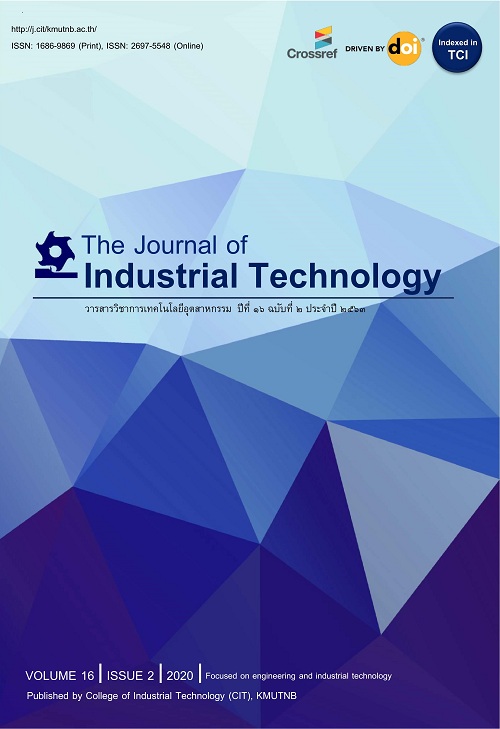Efficiency Enhancement of An Inductive Power Transfer System Used for Battery Charging Through Frequency Control and Compensation Adjustment
Abstract
การประยุกต์ใช้เทคโนโลยีการส่งกำลังไฟฟ้าแบบอินดักทีฟในการประจุแบตเตอรี่ช่วยทำให้เกิดความสะดวกและปลอดภัยในการใช้งานมากยิ่งขึ้น ขณะทำการประจุแบตเตอรี่ค่ากระแสหรือแรงดันของแบตเตอรี่จะแตกต่างกันออกไปตามสถานะประจุของแบตเตอรี่ขณะนั้น ตัวควบคุมของระบบจะต้องสามารถรักษากระแสหรือแรงดันในขณะชาร์จให้คงที่ตามรูปแบบการชาร์จที่ถูกกำหนดมาสำหรับแบตเตอรี่แต่ละชนิด โดยทำการส่งคำสั่งที่เหมาะสมเพื่อไปควบคุมการทำงานของสวิตช์กำลังภายในตัวอินเวอร์เตอร์ บทความนี้นำเสนอเทคนิคในการควบคุมระบบส่งกำลังไฟฟ้าแบบอินดักทีฟด้วยการควบคุมความถี่การสวิตช์ของอินเวอร์เตอร์ร่วมกับการปรับค่าตัวชดเชยเพื่อให้สามารถควบคุมกระแสหรือแรงดันชาร์จแบตเตอรี่ให้คงที่ในขณะที่สามารถรักษาประสิทธิภาพของระบบให้มีค่าสูงได้ ผลการทดลองที่ได้จากระบบทดสอบที่จัดทำขึ้นแสดงให้เห็นการเพิ่มขึ้นของประสิทธิภาพของระบบ โดยประมาณ 10 % สำหรับโหมดกระแสคงที่ และ 5% สำหรับโหมดแรงดันคงที่ เมื่อเทียบกับวิธีการที่ความถี่สวิตช์ถูกกำหนดให้มีค่าคงที่
Applying inductive power transfer (IPT) technologies for battery charging enhances user convenience and operational safety. While charging the battery, the current or voltage of the battery varies according to its state of charge. The system controller must be able to maintain a constant charging current or voltage according to the charging profile designated for each type of battery. This can be achieved by sending the appropriate commands to control the operation of the power switches inside the inverter. This article presents techniques for controlling an IPT system by varying the inverter’s switching frequency along with adjusting compensation parameters in order to achieve constant current or voltage charging while maintaining high system efficiency. The experimental results obtained from the testing system indicate an approximate 10% improvement in system efficiency for the constant current mode (CC) and 5% for the constant voltage mode (CV), compared to a fixed switching frequency scheme.
Keywords
[1] G.A. Covic and J.T. Boys, Inductive power transfer, Proceedings of the IEEE, Proceeding, 2013, 101(6), 1276–1289.
[2] Y. Li, R. Mai, T. Lin, H. Sun and Z. He, A novel WPT system based on dual transmitters and dual receivers for high power applications: analysis, design and implementation, Energies, 2017, 10(2), 1–15.
[3] J. Sallan, J. L. Villa, A. Llombart and J. Fco. Sanz, Optimal design of ICPT systems applied to electric vehicle battery charge, IEEE Transactions on Industrial Electronics, 2009, 56(6), 2140–2149.
[4] X. Liu and S.Y.R. Hui, Equivalent circuit modeling of a multilayer planar winding array structure for use in a universal contactless battery charging platform, IEEE Transactions on Power Electronics, 2007, 22(1), 21–29.
[5] W. Zhang and C.C. Mi, Compensation topologies of high-power wireless power transfer systems, IEEE Transactions on Vehicular Technology, 2016, 65(6), 4768–4778.
[6] G.A.J. Elliott, G.A. Covic, D. Kacprzak, and J.T. Boys, A new concept: asymmetrical pick-ups for inductively coupled power transfer monorail systems, IEEE Transactions on Magnetics, 2006, 42(10), 3389–3391.
[7] G.A. Covic and J.T. Boys, Modern trends in inductive power transfer for transportation applications, IEEE Journal of Emerging and Selected Topics in Power Electronics, 2013, 1(1), 28–41.
[8] Z. Liu, L. Wang, Y. Guo and S. Li, Primary-side linear control for constant current/voltage charging of the wireless power transfer system based on the LCC-N compensation topology, IEEE Transactions on Industrial Electronics, 2022, 69(9), 8895–8904.
[9] A.B. Khan and W. Choi, Optimal charge pattern for the high-performance multistage constant current charge method for the Li-ion batteries, IEEE Transactions on Energy Conversion, 2018, 33(3), 1132–1140.
[10] W. Zhang, S.-C. Wong, C.K. Tse and Q. Chen, Load-independent duality of current and voltage outputs of a series- or parallel-compensated inductive power transfer converter with optimized efficiency, IEEE Journal of Emerging and Selected Topics in Power Electronics, 2015, 3(1), 137–146.
[11] W. Zhang, S.-C. Wong, C.K. Tse and Q. Chen, Analysis and comparison of secondary series- and parallel-compensated IPT systems, 2013 IEEE Energy Conversion Congress and Exposition, Proceeding, 2013, 2898–2903.
[12] X. Qu, H. Han, S.-C. Wong, C.K. Tse and W. Chen, Hybrid IPT topologies with constant current or constant voltage output for battery charging applications, IEEE Transactions on Power Electronics, 2015, 30(11), 6329–6337.
[13] S. Bai, Z. Pantic and S. Lukic, A comparison study of control strategies for ZVS resonant converters, IECON 2010 - 36th Annual Conference on IEEE Industrial Electronics Society, Proceeding, 2010, 256–262.
[14] K. Aditya and S.S. Williamson, Design considerations for loosely coupled inductive power transfer (IPT) system for electric vehicle battery charging - A comprehensive review, IEEE Transportation Electrification Conference and Expo (ITEC), Proceeding, 2014, 1-6.
DOI: 10.14416/j.ind.tech.2024.08.014
Refbacks
- There are currently no refbacks.






